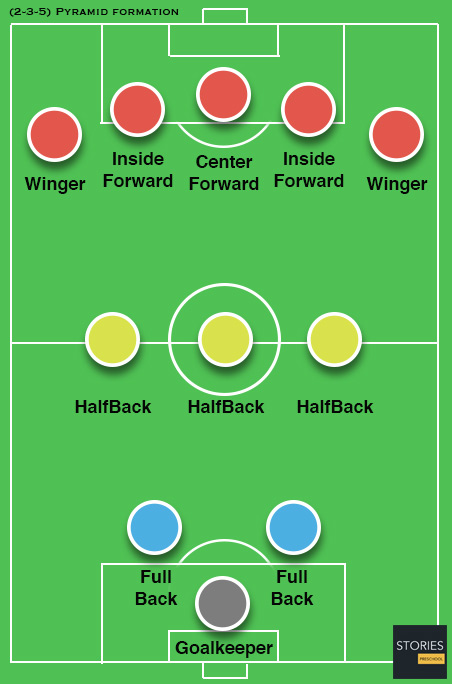Soccer

2-3-5 (Pyramid) Formation
The first long-term successful formation was first recorded in 1880. However, in "Association Football" published by Caxton in 1960, the following appears in Vol II, page 432: "Wrexham ... the first winner of the Welsh Cup in 1877 ... for the first time certainly in Wales and probably in Britain, a team played three half-backs and five forwards ..."

The 2–3–5 was originally known as the "Pyramid", with the numerical formation being referenced retrospectively. By the 1890s, it was the standard formation in England and had spread all over the world. With some variations, it was used by most top level teams up to the 1940s.
For the first time, a balance between attacking and defending was reached. When defending, the two defenders (full-backs), would zonally mark the opponent forwards (mainly the central trio), while the midfielders (halfbacks) would fill the gaps (usually marking the opposing wingers or inside forwards).
The centre halfback had a key role in both helping to organise the team's attack and marking the opponent's centre forward, supposedly one of their most dangerous players.
This formation was used by Uruguay to win the 1924 and 1928 Olympic Games and also the 1930 World Cup.
It was this formation which gave rise to the convention of shirt numbers.

Danubian School
The Danubian School of football is a modification of the 2–3–5 formation in which the centre forward plays in a more withdrawn position. As played by the Austrians, Czechs, and Hungarians in the 1920s, it was taken to its peak by the Austrians in the 1930s. It relied on short-passing and individual skills. This school was heavily influenced by the likes of Hugo Meisl and Jimmy Hogan, the English coach who visited Austria at the time.
SPORTS

RESOURCES
This article uses material from the Wikipedia articles "Association football" and "Formation (Association football)", which is released under the Creative Commons Attribution-Share-Alike License 3.0.
© Stories Preschool. All Rights Reserved.












